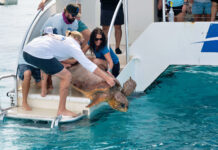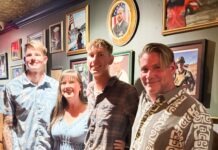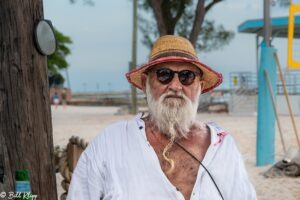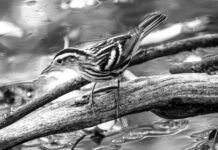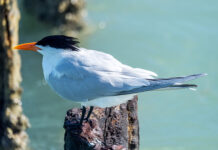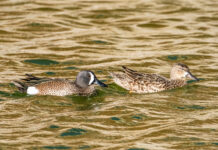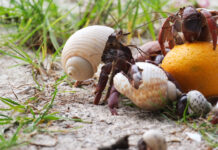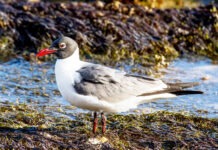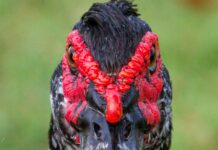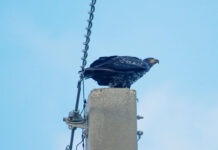A male sanderling in breeding plumage is something to see, a bird with a classic shorebird profile – horizontal torso, slim, longish bill, respectable set of black gams – wrapped in a complex serape of rufous feathers that range from coffee to deep bronze to wenge to almost black. Or so the field guides tell me. I’ve never seen one in breeding plumage.
Sanderlings are some of the most well-distributed birds in the world. The adjective most often used to describe them is cosmopolitan, which generally makes you think of urban avatars of couth, or at least Carrie Bradshaw’s favorite cocktail, but in reality means they are found on every continent but Antarctica.
Though found on every continent, they don’t breed on every continent. They breed in the high Arctic tundra – the northernmost parts of Alaska, Canada and Siberia, as well as, for some climatic reason, both middle and southerly parts of still-owned-by-Denmark Greenland.
The everywhere-but-Antarctica part of their range map is much broader in non-breeding season, which is the boreal winter. The Cornell Lab of Ornithology’s generally stodgy and linguistically restrained “Birds of the World” website says the species “may be found on almost any sandy beach, anywhere on the planet!” with the exclamation point seeming almost wanton compared to the rest of the site’s prose.
The females are a little less dramatically colored than the males, but there is still a little warmth in their hues.
When they are inhabiting the world’s beaches, i.e. when we get to see them, neither gender is imbued in the aforementioned 1970s autumnal color palette. Instead, both male and female are a minimalist gray above and white below. It’s a color palette I tend to think of as radically inoffensive, the kind of color schemes you see in Dwell magazine or the homes of people who hire other people to pick out their furniture, and still other people to clean it.
Despite the fact that they breed in the Arctic, you can find them in the Keys year-round. I don’t think I’ve gone a single month in the last two decades or so without seeing one or more sanderlings if I’m in town.
Why shorebirds that breed in other places can be readily found during their breeding months in a place they don’t breed is something of a mystery. Sanderlings don’t breed until their second year. So it’s possible some of the ones we see here in the summer are immatures that didn’t migrate back for the summer. It’s also possible they are birds of breeding age that just didn’t migrate for some reason, like illness or a general disinclination.
I’ve always wondered why the sanderlings we see here in the summer keep their gray and white non-breeding plumage. Maybe the hormonal change that was supposed to inspire them to fly north didn’t happen, and the same hormonal shortfall kept the breeding plumage from coming in. Maybe returning to their breeding territory is what triggers the plumage change in sanderlings. The only thing I do know is I haven’t seen a sanderling looking remotely rufescent down here.
The sanderling is one of those rare species in North America with a mononym – a single word name. It’s that cosmopolitan-ness again. There is no northern sanderling or southern sanderling. There is just sanderling.
The name is derived from Old English. Some sources say the etymology is simple – a diminutive moniker for a creature that lives on sandy beaches. Other sources say it comes from sand-yrðling or sand-yrthling, the yrðling or yrthling part meaning plowman, or more specifically, farmer, as in a creature that farms the sand. Still other sources say the word derives from sand and eel because, I don’t know, pulling tiny crustaceans out of the sand is somehow eel-like?
They are often described as feeding in small, conspecific flocks, meaning generally feeding only with other sanderlings. But when I first started birding it seemed I always saw them working the same patches of sand and seaweed as ruddy turnstones. They were the Abbott and Costello of the shorebird world, the peanut butter and jelly. You rarely saw one without the other.
Ruddy turnstones are also a rather cosmopolitan species, a little bigger than sanderlings, a little bulkier, with a stubbier bill, orange legs, a somewhat more fiery rufescence in breeding season, and a striking black pattern in the face that is usually described at harlequin-esque.
In recent years sanderlings seem to have become more common and ruddy turnstones less so. I can’t remember the last time I saw a ruddy turnstone. Which doesn’t necessarily mean anything. Birds move around a lot. Whether you cross paths with them or not doesn’t always have a lot to do with whether they’re around or not.
But I got curious and went to the International Union for Conservation of Nature’s Red List page, which tracks the general population health of over 166,000 birds, mammals, reptiles, trees, corals, fish, and members of the plant and animal kingdoms.
According to the IUCN, the sanderling is a species of least concern, with a population decreasing in some parts of its range, but increasing in others. As of 2019 the ruddy turnstone was also considered a species of least concern. But in July of last year it was re-ranked as nearly threatened, with an estimated decrease in its population of 20%-26% over the last 18 years.
While that decrease in population is troubling, it would not account for me not seeing any in the last year or two. So I went to eBird to look for recent records, and yes, they are still seen pretty commonly at places like Higgs Beach, White Street Pier and Fort Zach. (If you ever want a nearly sure way to see a ruddy turnstone, have lunch at Keys Fisheries in Marathon. But don’t give them any French fries. It is really unhealthy for them.)
So I’m going to keep my eyes a little wider, and hopefully catch sight of a ruddy sometime soon.
I’m also considering heading to the far north one of these days, if only to see sanderlings in their seasonal finery.





